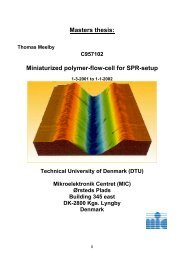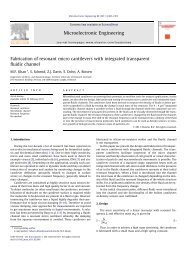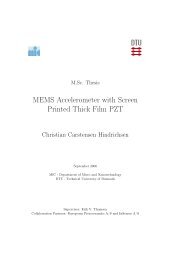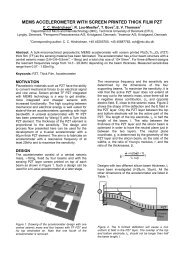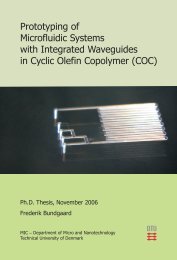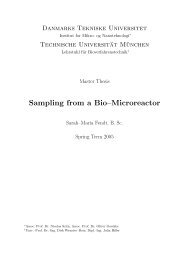Development of a Oxygen Sensor for Marine ... - DTU Nanotech
Development of a Oxygen Sensor for Marine ... - DTU Nanotech
Development of a Oxygen Sensor for Marine ... - DTU Nanotech
You also want an ePaper? Increase the reach of your titles
YUMPU automatically turns print PDFs into web optimized ePapers that Google loves.
4.2. ACTUAL DESIGN 29<br />
seen on figure 4.2 have been to create a layout, which as mentioned earlier,<br />
would have a high chance <strong>of</strong> working. Thereby enabling me to do some<br />
measurements with it, so that some practical experience could be gathered.<br />
Also <strong>of</strong> course to see if it did indeed work, and what response could be<br />
expected from it. The design is basically an array <strong>of</strong> Pt working electrodes<br />
located in the middle, then a torus shaped Pt counter electrode surrounding<br />
it, and finally a circular Ag/AgCl reference electrode around the two <strong>of</strong> them.<br />
Extreme care has been taken to avoid, or at the very least minimize, the<br />
chances <strong>of</strong> any short circuits. Put in other words each electrode have its own<br />
connection to the outside via a silicide ’wire’, that touches neither the other<br />
electrodes, nor the other ’wires’. Also there is a temperature sensor at the<br />
top, more about this later however.<br />
Figure 4.2: Primary/Safe Design, the white circles are where the ’O’-ring will<br />
be placed on the chip, showing both the actual inner and outer<br />
diameter <strong>of</strong> it, as well as where it minimally will touch the chip.<br />
The number refer to the design, while the roman numerals refer<br />
to the size and distance between the electrodes in the array. For<br />
a closeup <strong>of</strong> the Working Array see Figure 4.6



